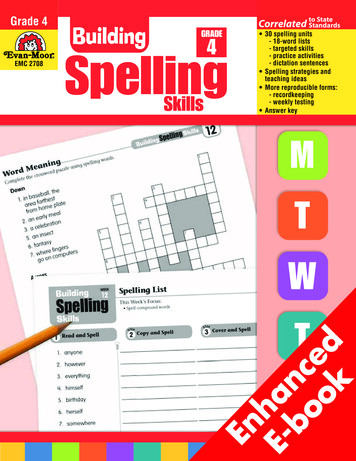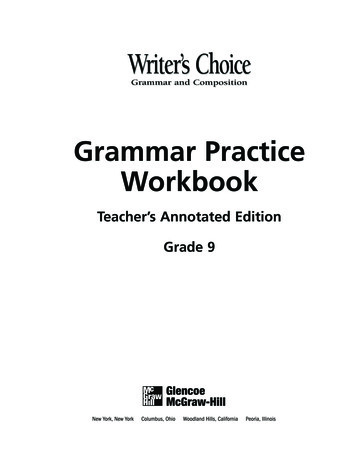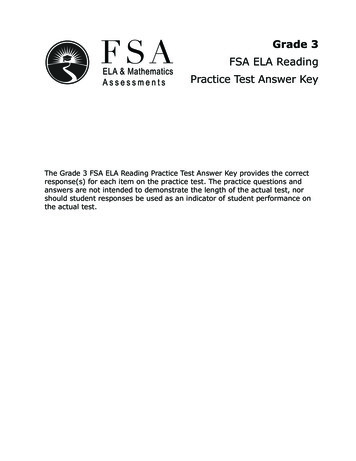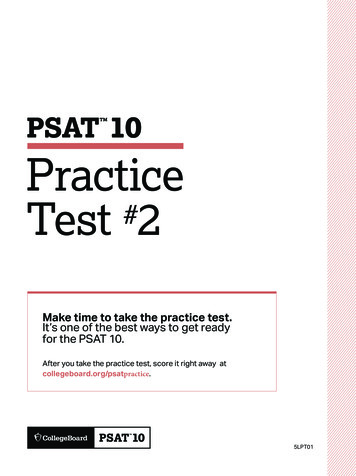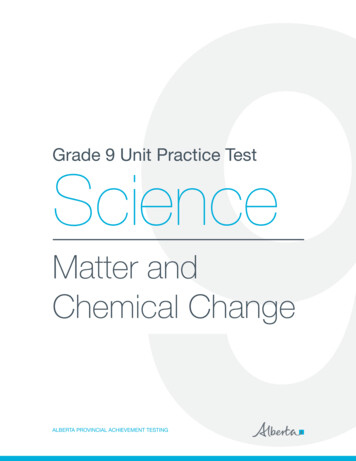
Transcription
Grade 9 Unit Practice TestScienceMatter andChemical ChangeALBERTA PROVINCIAL ACHIEVEMENT TESTING
Copyright 2020, the Crown in Right of Alberta, as represented by theMinister of Education, Alberta Education, Provincial Assessment Sector,44 Capital Boulevard, 10044 108 Street NW, Edmonton, Alberta T5J 5E6,and its licensors. All rights reserved.Special permission is granted to Alberta educators only to reproduce,for educational purposes and on a non-profit basis, parts of thisdocument that do not contain excerpted material.
1.Which of the following rows identifies an element that is common to both combustionand corrosion reactions and identifies whether this element is a reactant or product of thereaction?RowElementReactant or antD.WaterProductUse the following information to answer question 2.Physical Properties of Four ElementsElement2.BoilingPoint ( C)ColourConductivityMalleabilityI9622 162Lustrous urlessGoodinsulatorNotmalleableIII115445IV1 0642 856Yellow?NotmalleableLustrous yellow?VerymalleableWhich of the following statements describes the conductivity of elements III and IV?A.B.C.D.3.MeltingPoint ( C)Both elements are good insulators.Both elements are good conductors.Element III is a good conductor and Element IV is a good insulator.Element III is a good insulator and Element IV is a good conductor.What is the chemical name of a molecular substance that is composed of one carbon atomand four chlorine atoms?A.B.C.D.Carbon tetrachlorineCarbon tetrachlorideCarbon chlorineCarbon chloride1
4.Which of the following statements about helium, neon, and argon is true?A.B.C.D.They have the same number of protons.They have the same number of neutrons.They are solids at a temperature of 25 C.They react with other substances in a similar way.5. Which of the following rows identifies both the elements and number of atoms that arepresent in one molecule of C6H12O6?Row6.Carbon, helium, and oxygen12B.Carbon, helium, and oxygen24C.Carbon, hydrogen, and oxygen12D.Carbon, hydrogen, and oxygen24Which of the following events is an example of a chemical change?Liquid nitrogen evaporates.A candle burns.Water boils.Ice melts.Which of the following rows matches the type of element with the type of compound thatforms when two elements of that type are combined?Row8.Number of AtomsA.A.B.C.D.7.ElementsType of ElementType of tallicIonicD.Non-metallicMolecularWhich of the following substances is classified as a solution?A.B.C.D.Acid rainTable saltHelium gasBaking soda2
Use the following information to answer question 9.A student tests the reactivity of four metals by placing a piece of each metal into 200 g/Lof hydrochloric acid. Each piece has an initial mass of 4.0 g. The student records herobservations in the following table.MetalTemperature of Solution After MetalReacts with Hydrochloric Acid ( C)Mass of Metal After it Reactswith Hydrochloric Acid (g)1281.82293.23421.44352.09. The information in the table shows that the metal that reacts most readily withhydrochloric acid isA.B.C.D.1234Use the following information to answer question 10.A Model of a Molecule10. The chemical formula for the unknown molecule shown above isA.B.C.D.P2H5OHP2H5CHC2H5OHO2H5CH3
Use the following information to answer numerical-response question 1.A student who burns a piece of magnesium that has a mass of 70.2 mg makes the followingobservations. Heat is generated. An intense white light is emitted. A mass of 130.8 mg of white magnesium oxide ash is produced.Numerical Response1.Themass of oxygen that reacts in the chemical reaction described above is(Record your answer.)Use the following information to answer question 11.During a laboratory experiment, four students each combined two substances and recordedtheir observations.StudentObservation of SubstancesI and II CombinedSubstance ISubstance II1White solidClear liquidClear liquid that remainsat room temperature2Clear liquidBlue solidBlue liquid3White solidClear liquidClear liquid that bubbles4Yellow liquidWhite solidWhite solid that floats ontop of the yellow liquid11. Which student most likely produced a new chemical substance?A.B.C.D.Student 1Student 2Student 3Student 44mg.
12.Which of the following rows identifies both the elements and the total number of atoms thatare present in one molecule of CH3COOH(aq)?Row13.Carbon, helium, and oxygen3B.Carbon, helium, and oxygen8C.Carbon, hydrogen, and oxygen3D.Carbon, hydrogen, and oxygen8The number of electrons in one beryllium atom is9542Which of the following pairs of elements have the most properties in common?A.B.C.D.15.Total Number of AtomsA.A.B.C.D.14.ElementsFluorine and oxygenFluorine and chlorineSodium and neonSodium and magnesiumWhich of the following rows classifies the type of compound formed when sodium andchlorine react together and states whether this compound conducts electricity whendissolved in water?RowType of CompoundConducts Electricity WhenDissolved in o5
16.Which of the following statements describes a physical property of a substance?A.B.C.D.Hydrochloric acid produces heat when mixed with zinc.Phosphorous burns when exposed to air.Lithium reacts violently with water.Copper conducts electricity.Use the following information to answer question 17.Rutherford used the solar system as a model to explain the structure of an atom.17.When this model is compared to an atom, the planets represent theA.B.C.D.protonsnucleusneutronselectronsUse the following information to answer question 18.A group of students conducts an experiment to determine the effect of temperature onreaction rates. They perform three separate trials in this experiment. In the first trial, theydrop an antacid tablet into a beaker of water at a temperature of 40 C and record how longit takes the tablet to completely dissolve. In the second and third trials, they use the sametype and amount of antacid, but they change the temperature of the water to 25 C for thesecond trial and 5 C for the third trial.18. The manipulated variable in this experiment is theA.B.C.D.type of antacid usedamount of antacid usedtime it takes for the reaction to occurtemperature at which the reaction occurs6
Numerical Response2.For each of the elements given below, indicate whether it is a metal or non-metal using thefollowing code.1 Metal2 Non-metalAluminumFluorineLithium(Record all four digits of your answer.)7Phosphorus
Science 9 – Practice Test 2019Matter and Chemical Change KeyQuestion #in B15C16D17D18DNR21212
Science 9 Unit Practice Test - Matter and Chemical Change Author: Alberta Education - Government of Alberta Subject: Science 9 Keywords: Science 9, unit practice test, matter and chemical change, alberta provincial achievement testing Created Date: 1/23/2020 12:28:55 PM




